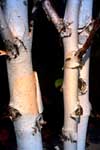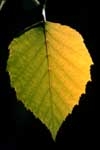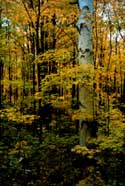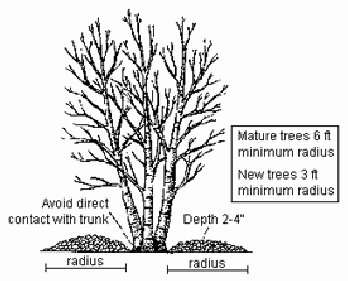Birch trees (Betula spp.) are a popular choice for the home landscaper. Their distinctive bark and beautiful leaves make them prized shade and ornamental trees. However, they do demand a little care and attention. Not just any site or soil condition will do and many trees fail to reach maturity due to site and soil factors.


The birch and its characteristic bark (left) and the leaf of a paper birch (right)
Probably the most important factor for a healthy birch tree is good soil. The type of soil determines not only how much nutrients and
water the plant has access to, but also how efficiently the tree can use those nutrients.
This can determine whether your birch can successfully withstand the stresses of
growing in an urban environment of be able to fend off pests such as the bronze birch
borer. As a homeowner, the best contribution you can make to your birch tree's soil
and to the long-

A birch tree in its natural habitat.
In the natural environment, the birch is a riverbank tree with a preference for well-
The challenge for the homeowner is to satisfy these two requirements. An ideal site is one which allows the crown access to sunlight for the better part of the day, yet where the base of the tree is sheltered from extreme heat and evaporation. In practical terms, this means avoiding planting birches as single trees in exposed areas.
From the standpoint of soil, birches have a preference for slightly acidic over alkaline conditions although slightly alkaline soils will work in combination with periodic fertilizer treatments.

Improving your soil should be a priority when thinking of your birch tree's health. Mycorrhizal fungi is a wonderful and beneficial addition to your soil.
Fertilization is also important. You may have heard that you can simply use the same fertilizer you use on your lawn. That is not the case. Lawn fertilizers tend to have a large proportion of Nitrogen which does promote growth, but at
the expense of other developmental areas. Too much nitrogen will also burn out the
soil over time. You should ensure that you use a fertilizer suited to birch trees
that will promote root development, disease resistance and long-
Depending on the soil in the local area, it is possible for Birch trees to show signs of iron deficiency. The most common symptoms of iron deficiency are seen on the younger, newly formed leaves, which appear pale green or yellow. When you examine the leave you can see a distinct skeleton pattern on the leaf surface because the veins in the leaf remain green but the soft tissue of the leaf is yellow or pale green. In extreme cases of iron deficiency, the new leaves are all yellow, smaller in size or completely stunted.
Trees often suffer from iron deficiencies, as well as deficiencies of other micronutrients such as copper, zinc and manganese. The deficiencies can occur when the nutrients are depleted in the soil or when the ph level is very alkaline, meaning over a reading of about 7.0. At ph levels over 7.0, trees have a difficult time utilizing key nutrients such as iron. Excessive use of lime or the leaching of lime from gravel, cement and bricks can cause the alkaline soil condition. This is a very common situation where recent construction has occurred or new patio stones have been installed. Alkaline soils are also common in geographical regions where limestone is prevalent and rainfall is low.
It is easy to correct an iron deficiency. Simply place chelated iron tablets in the
soil at the tree’s drip-
Aside from soil improvement, access to adequate moisture is critical for a healthy birches. During dry periods, particularly in the spring, birches will need watering. An effective method is by arranging a dripper hose upside down around the tree's drip line and watering continuously for between six and ten hours. This should ensure adequate moisture to a depth of between 1.5 and three feet. In areas suffering from drought or municipal watering restrictions, a helpful way to maintain moisture around a tree’s root zone is by using Hydretain Root Zone Moisture Manager. Hydretain is a blend of hydroscopic and humectant compounds that attract and hold moisture, like tiny “water magnets” within the soil. Each application reduces the frequency of watering for up to 3 months and is a helpful tool for tree care during prolonged hot, dry conditions and to improve transplant survival. In some situations, another useful method is to place water spikes around the dripline. This can provide a more constant source of moisture. Watering frequency should decrease in the fall to allow the tree to prepare for winter.
In order to hold moisture and further protect the root system from excessive heat and evaporation, mulching is important. For material, use organic mulch, wood chips or leaf compost. (see above diagram for mulching guidelines)
Finally, use care when operating lawn mowers or other machinery around the base of birch trees. The bark is easily damaged and wounds are an open invitation for insects and disease. The pruning of birch trees should be avoided unless absolutely necessary. Pruning of birch trees in spring causes high sap flow, attractive to migrating beetles. In an area with high incidence of bronze birch borer, avoid pruning. If necessary, prune in the fall during the tree's dormancy period. Wound dressings are ineffective.